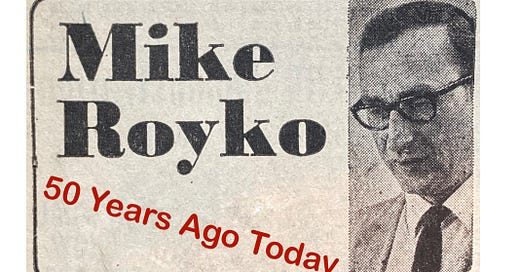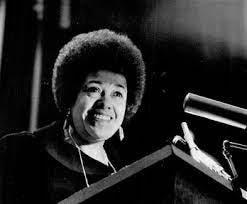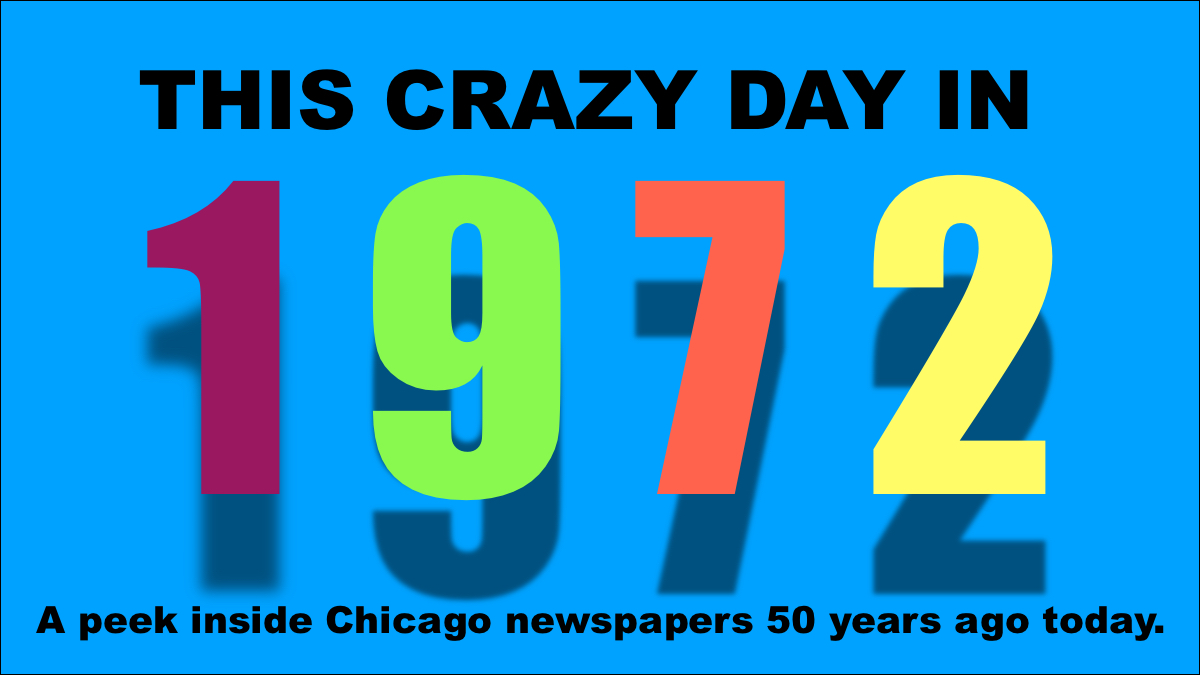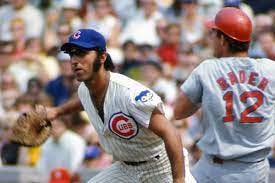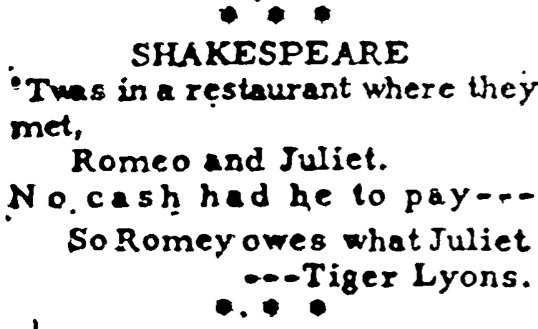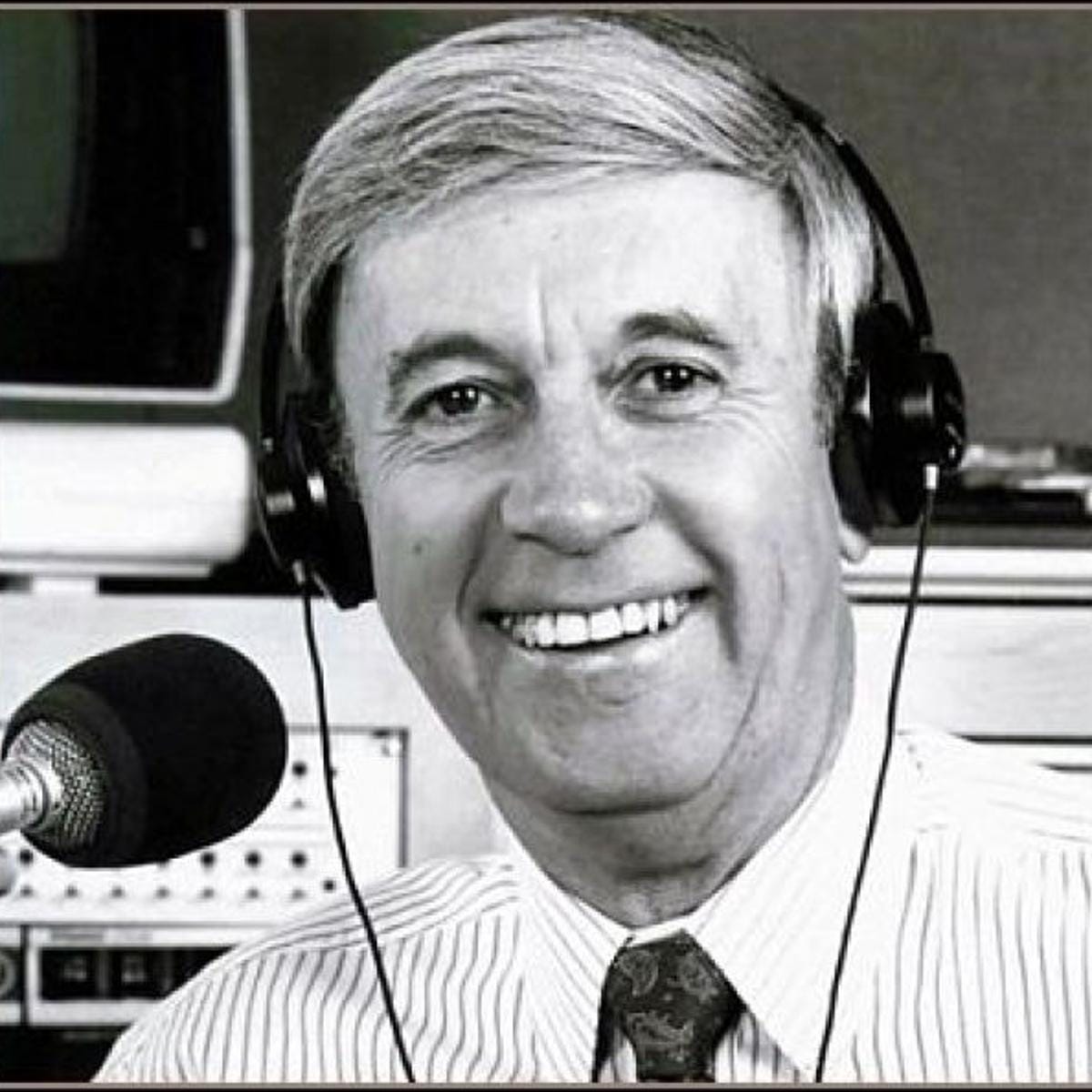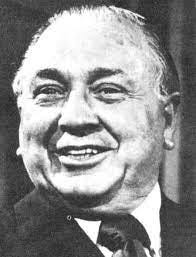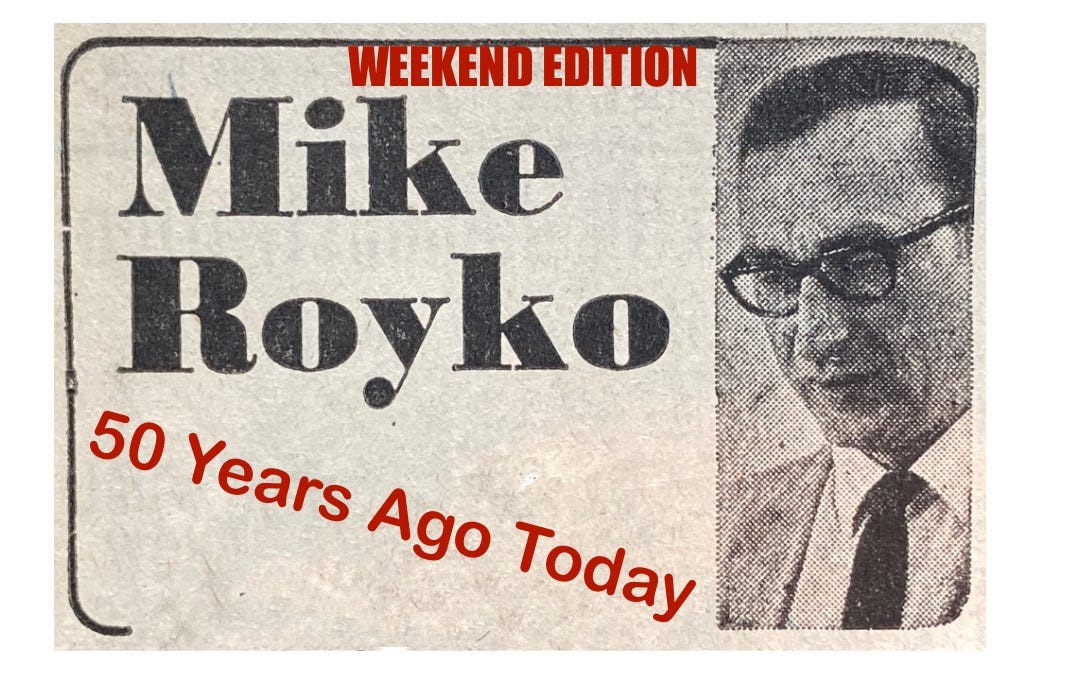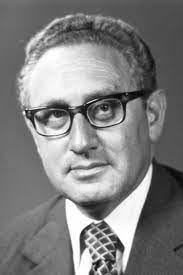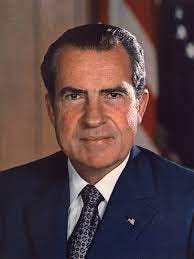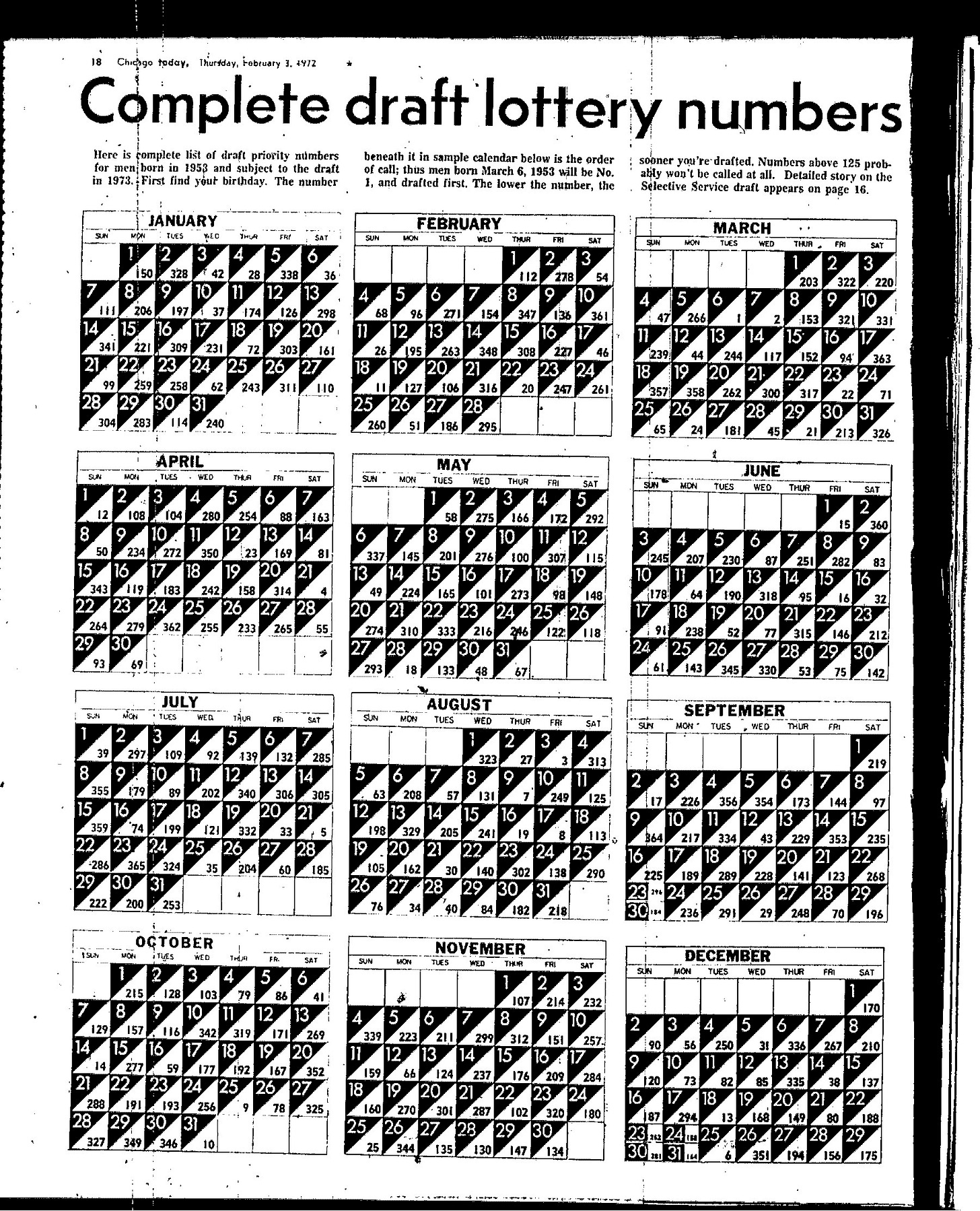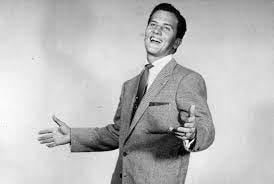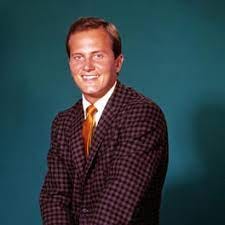To access all site contents, click on the rose icon in the upper left corner or HERE.
Why do we run this separate item, Mike Royko 50 Years Ago Today? Because Steve Bertolucci, the hero of the serialized novel central to this Substack, “Roseland, Chicago: 1972,” lived in a Daily News household. The Bertoluccis subscribed to the Daily News, and back then everybody read the paper, even kids. And if you read the Daily News, you read Mike Royko. Get your Royko fix on Twitter too— @RoselandChi1972.
A little history fun further down in Mike’s May 24 column!
May 22, 1972
This column was laugh-aloud satire in 1972, but today it requires some background for Younger Readers especially.
Exactly one week ago in 1972, Alabama Gov. George Wallace was shot five times while campaigning in Maryland for the Democratic presidential nomination. This column is a response, continuing Mike’s approach to gun control. From news reports, 1972 readers know that Wallace will likely be paralyzed, though he vows not to drop out of the race. See last week’s THIS CRAZY DAY IN 1972 compilation for coverage of the Chicago coverage.
Mike didn’t write about Wallace’s attempted assassination all last week. Unlike most columnists today, Mike doesn’t automatically weigh in on big national issues instantly. Sometimes he does; his column following the assassination of Martin Luther King is notable, and timeless. (See the Weekend Edition here for a look at that column.)
Mike may have been less motivated to write about Wallace, a politician notorious for his opposition to desegregation—including his inaugural declaration, “segregation now, segregation tomorrow, segregation forever.” During Wallace’s first term as governor, he stood in the doorway of a University of Alabama building to physically block Black students from entering.
Last week, prominent politicians, including Black politicians, forced themselves to publicly deplore the Wallace shooting and voice hope for his recovery. Ald. Anna Langford (16th) got attention as possibly the only one who said what she was really thinking: “He is a violent man and when you live violently you die violently.”
As the Wallace shooting demonstrates, Americans in 1972 were traumatized not by mass shootings with automatic weapons, but by political assassinations. The killings of John F. Kennedy, Robert F. Kennedy, and Martin Luther King were all recent tragedies for Mike’s readers. Mass shootings were still unusual, and mass shootings in elementary and high schools unknown.
Americans in 1972 were typically familiar with just two mass shootings at that point.
First, the 1949 “Walk of Death” in Camden, New Jersey in which former World War II soldier Howard Unruh used a handgun to randomly shoot and kill 13 people during a walk near his home. Unruh’s rampage is generally considered the first modern U.S. mass shooting.
The second mass shooting occurred in 1966 at the University of Texas, when Charles Whitman stabbed his mother and wife to death before climbing to the observation deck of the campus’s main building, a tower with a clock at the top. There, Whitman randomly shot and killed 14 people over the next 96 minutes, mainly with a rifle.
You can see that in 1972, mass shootings were still few in number, and not frequent. They could still be considered strange anomalies. Political assassinations seemed to be on an ever-increasing trajectory.
As we know now, assassinations did not become so endemic that all personal political campaigning and appearances ended—which many people in 1972 fully expected.
Instead, 50 years after Mike’s column today, the nation is convulsed in grief over yet another horrific mass shooting of young children in their classroom, this time in Uvalde, Texas on May 24, 2022, by an 18-year-old with an assault weapon and body armor.
So keep all that in mind. And again, remember this column is satire. Contemporary readers are disturbed that political assassinations are on the rise, but Chicagoans aren’t heartbroken about George Wallace personally. And nobody has in mind the images of young children mowed down by automatic weapons.
In addition, let’s remember that the point of satire isn’t just to be funny. It’s to make a point more trenchantly than serious writing. In that sense, the best satire on an important topic should make you laugh even as it disturbs the hell out of you. A 1972 reader would have been able to laugh at this column; we can all still be disturbed as hell.
Here we go.
Mike’s lede:
“The shooting of George Wallace has created still another wave of anti-gun sentiment and demands that our gun laws be toughened.
“This happens every time a candidate for President is shot.
“The majority of editorials and columns seem to favor increased restrictions. I am one of the few columnists who does not.
“To the contrary, I would like to see the gun laws relaxed so that it would be legal for me to buy my own machinegun.”
By the way Younger Readers, Americans in 1972 had not been arming themselves with assault weapons for years. Of course, the country had always been awash in guns. But not assault weapons and body armor and exploding bullets. So the idea of average people legally owning machineguns was pretty out there, readily recognizable as satire—and funny.
As Mike notes later in the column, he’s been advocating for legal machineguns for years, and he’s “disappointed” by the lack of support from the gun lobby. I don’t know when the gun lobby switched from not supporting machineguns to supporting assault rifles.
“The reason I want a machinegun is that I am a very bad shot with a pistol or rifle, due to having a prominent nose that obstructs my vision while aiming,” Mike explains. “Therefore, I am unable to properly defend myself. But with a machinegun, I would have a fighting chance.”
Among the other common sense reasons Mike gives for supporting machinegun ownership is that they are “much safer to have around the house than a pistol.
“A child can easily discharge a .32 he finds in his father’s dresser. We hear of this happening all too frequently.
“But it would be difficult for a child to load an ammunition belt or magazine into a machinegun. And even if he did, it would be virtually impossible for him to shoot himself. The worst that could happen is that he might shoot some of his playmates. But, then, nothing is absolutely foolproof.”
If you dig Mike Royko, you’ll want to see the news he’s writing about. Check it out here!
May 23, 1972
Chicago public school teachers are likely going to strike this week on Thursday. Last weekend, we learned that teachers had just elected a new pro-strike president, Robert M. Healey. Healey helped draft the strike resolution. On Monday, which is yesterday, the teachers narrowly approved that resolution.
Why?
The Chicago School Board could’t figure out any other way to pay its bills this year than to close school 11 days early, thus saving $22 million in salaries while meeting state requirements by holding just 178 days of class. That would be less money in all teachers’ pockets, though they would be paid their contractual daily wage. Plus, the School Board is considering cutting 2,690 teaching positions in music, art and physical education next year due to budgetary constraints. The letters section in every Chicago newspaper has exploded with reader rage at that idea.
Newly-elected CTU President Healey argued during his campaign that by striking now, rather than in the fall, Chicago schools wouldn’t meet the 177-day state requirement.
“The Board of Education could lose $1.7. million a day in state aid for each day less than the 177,” wrote the Daily News. “This situation, Healey said, would place the union in a stronger position for bargaining.”
Rev. Jesse Jackson’s new organization, Operation PUSH, is against the strike, calling it “detrimental to the most important people—the children.”
This is all to say that my guess is that today’s column is not meant to be satire in the sense that Mike is writing over-the-top against the teachers in order to make the complete opposite point—in other words, deploying the comedic tactic that Stephen Colbert later used for 30 solid minutes minus commercials five nights a week on “The Colbert Report.” My guess is that Mike really does not support the teachers here. Feel free to advocate the opposite in comments!
“I had just finished the regular Sunday softball game and was walking through the heat of Lincoln Park to join my teammates for a beer,” Mike starts today. “Then this woman walked up.”
The woman was a teacher. She wanted to talk about the strike.
“Before she could finish, I began waving my arms and sputtering about a person’s right to play softball, have a beer, and not be plagued by teachers and their damn strike.”
We all know how Mike Royko felt about softball, so this is certainly believable.
“They are in a perpetual state of threatening to strike, voting to strike, going out on strike, coming back from strike,” writes Mike.
“There is a limit, and that limit is reached when a person just wants to play softball and have a beer.”
The teacher left, which Mike believed was probably because he had a bat in his hand.
Mike goes on to say he doubts a few less days of school will make any difference for students who aren’t doing well, or for students who are doing just fine anyway.
“The most painful part of the drip, drip, drip of the teachers and their strikes is they expect anybody to believe they are doing it all for the children,” he writes. “I have yet to hear one teacher say: ‘I want more money, all the money I can get.’”
Mike supports unions generally, he points out—not long ago he mentioned in another column that he himself is a dues-paying member of two unions. But the teachers threatened to strike last year for the good of students, he says, then settled for more money “even though they should have known the money wouldn’t be there. Now that it isn’t there, they are striking because they want it anyway. And they even said they want to be paid for the days they are on strike, which is nice work if you can get it.”
May 24, 1972
Yay! It’s always fun when Mike interacts with readers. Two samplings today.
ONE:
“WOJ WOJCIECHOWSKI, Chicago: The trouble with the peaceniks is that they don’t want to face up to the problem of communism. They’d rather let their kids worry about it, and do the fighting for them.
“Either we fight the Communists in their own back yard now, or we abdicate our responsibilities to future generations.”
For Younger Readers: Woj means we have to fight the war in Vietnam forever.
“COMMENT: That’s telling ‘em, Woj. By the way, what are you doing, sitting in your own back yard?”
TWO:
“TIGER LYONS, N. Ozark Av—Your life proves that anybody in America, no matter how humble their circumstances, can grow up and become a twerp.”
“COMMENT: Because you are one of this city’s chronic letters-to-the-editor writers, I knew that some day you would write to me, and that I could then reveal that your name isn’t ‘Tiger Lyons,’ as you always sign it, but John Joseph Lyons. Have you ever thought seriously about why you call yourself ‘Tiger?’ Of course, such self-analysis can be uncomfortable. Maybe some things are best left buried. But write again, John Joseph, any time.”
Wow, Mike must hate that jerk Tiger Lyons, right?
Not so fast.
Naturally I wondered just how often Tiger Lyons wrote to the papers.
The answer:
Everywhere, and I mean everywhere, Tiger wrote letters to the editor. But Tiger’s true forte was the topical quip, particularly topical sports quips, which he contributed to various newspaper columns along with sports letters in years-long spurts here and there, switching papers and specific columns from time to time—usually maintaining a steady presence in at least two papers at a time. When I say “contribute,” I mean Tiger sent his jokes everywhere, for free. Today, he’d be spending most of his free time on Twitter.

When you type Tiger’s name into the Daily News archive, he gets 891 hits. True, the Daily News archives include duplicates from multiple editions. If you assume a max of three hits for each single appearance in the paper, that’s still almost 300. Tiger’s first Daily News appearance is in 1958, his last in 1976. The paper ended, as we all here know, in 1978. Tiger was a regular in the Daily News’ “Voice from the Grandstand” column, initially in Bill Furlong’s tenure, and then under John Justin Smith in the late ‘60s and early ‘70s, when he also began regularly quipping on non-sports topics for Robert Herguth’s “Herguth’s People” column on page 5.

But Tiger wasn’t all sports. I don’t have time to become an expert on 1950s TV, though I believe the first allusion below is to the long-running “Gunsmoke.”
Tiger was not omniscient. Here he is in July 1959:
Here’s Tiger’s start in John Justin Smith’s “Grandstand” in 1968:
John Justin Smith so valued Tiger’s contributions, he added a little tiger cartoon for Tiger’s appearances. Here, in honor of Memorial Day, is Tiger’s 1970 Memorial Day thoughts:
Here’s a Tiger sample from Herguth’s May 12, 1972 column, commenting on Joe Pepitone’s “retirement” from the Cubs, covered on May 2 in THIS CRAZY DAY IN 1972.
But that’s not all! Tiger appeared 38 times in the Chicago Sun during its short initial life before merging with the Times and becoming the Sun-Times. Here’s a bit from 1948 to give you an idea of Tiger’s range.
I only have access to about two years of Sun-Times digital archive prior to its other archive available from 1986 on. Tiger got 369 hits in the early archive, just from 1948 to 1950. Jumping to the 1986-onward archive, Tiger is a regular in Kup’s column until 1999 (Kup died in 2003), when he switches mainly to Ron Rapoport’s sports column.
Tiger started throwing quips at the Tribune in 1951 in Arch Ward’s iteration of the Trib’s “In the Wake of the News” column, sometimes appearing weekly, then stopping for a year or so at a time. In July 1959, Tiger Lyons begins a long string of appearances in Herb Lyon’s “Tower Ticker” column that continues not quite monthly through June 1968. A connection there perhaps? Not per Tiger’s obituary, which we’ll get to. Sadly, Tiger’s last appearance in Lyon’s “Tower Ticker” was one of Herb Lyon’s final columns before entering the hospital and dying of cancer at 49.
After that, Tiger began a spate of appearances in the Trib’s “Sound Off, Sports Fans” column. Tiger absolutely dominates contributions to that column starting near the end of 1970, during all of 1971, and then he abruptly stops in March 1972 and switches to the Trib’s ancient “Line O’ Type” item.
In May, as Mike writes today’s column, in addition to Tiger’s Daily News appearances, he’s contributing quips every few days to the Trib’s “Line O’ Type,” continuing through 1974. In fact, in 1974 Tiger is an absolute Tribune tour de force between “Line O’ Type,” “Sound Off Sports,” and Aaron Gold’s iteration of “Tower Ticker.” Then Tiger just stops, on December 24, 1974, never to appear in the Tribune pages again until his paid death notice.
At first I thought Tiger Lyons might have been a drinking buddy of Mike’s at the Goat, because I initially saw a 1996 Tribune obituary for John “Tiger” Lyons. That Tiger Lyons, then 74, was “a long-time press operator for the Chicago Tribune and Chicago Sun-Times” who served in submarines in World War II—which naturally made me picture Mike, Harry Homewood and Tiger Lyons all having a beer at the Goat together. (See the Weekend Edition here for Harry Homewood.)
But no! The 1996 Tiger Lyons was, to be irreverent, a dead ringer. The real Tiger Lyons, for our purposes, got a full-fledged obituary in the Sun-Times, where he finished his quipster career in Ron Rapoport’s sports column.
“Some of the laughter went out of Chicago Sunday. Tiger Lyons died,” wrote Brenda Warner Rotzoll in the Sun-Times on March 6, 2002.
“His bitingly topical wit tickled the fancies of generations of Chicagoans who read his quips in news, sports and celebrity columns in the old Daily News and the Sun-Times, and on call-in radio shows including the old Wally Phillips show on WGN. He used to appear regularly in Kup's column and in the people column that Robert Herguth Sr. wrote.”
“I'm not sure what I did to deserve him, but he gave me more laughs, and more items, these last few years than any one notes columnist had a right to,” Rapoport wrote of Tiger in his own column.
Tiger would have been born in 1931, a year before Mike, so they were contemporaries.
Per Rotzoll’s article, Tiger Lyons was a long-time resident of far Northwest side Edison Park, but grew up on the West Side “where he hung out at a vacant lot near what was then the Congress Expressway, playing baseball and roasting potatoes in bonfires.”
During high school at Quigley Prep—she doesn’t say Quigley South, so I guess she means downtown—Tiger worked part-time “in the freight tunnels at Marshall Field’s.” Those would be the freight tunnels that were flooded by the Chicago River in 1992.
According to Rotzoll, “He earned the nickname ‘Tiger’ because his pals were from Auburn High School and followed the fortunes of Auburn's football team, the Tigers.”
After serving in the Korean War, Tiger graduated from Loyola on the GI Bill and became an accountant. He married teacher Bridget McDunough in 1970, and they were blessed with four children. You can imagine that the kids, and Bridget, may have rolled their eyes a bit at Dad’s newspaper contributions over the years—and now I bet they have a great big scrapbook to sit and read with the grandchildren.
So did Mike Royko hate Tiger Lyons, and did Tiger Lyons think Mike Royko was a twerp?
I’m pretty sure no. Maybe Mike and Tiger didn’t hang out at the Goat—Ron Rapoport wrote that he never met Tiger, or even talked to him on the phone. But Tiger’s note to Mike is completely out of character from his decades of fun, corny, never mean-spirited contributions to papers all over town.
Somehow, I feel sure, Mike knew Tiger and this was a huge joke between them.
If anybody knows Tiger’s kids, wouldn’t you love to hear what a kick Tiger got out of reading Mike’s column on May 24, 1972? Please pass it along, readers, if you can.
May 25, 1972
If you didn’t read Mike’s first column in this post, do so now and come back.
“A few nights ago I was awakened by sounds outside the window. They sounded like footsteps in the gangway.
“My first thought was that it had to be either a dangerous criminal or a Communist. And there I was without a machinegun.”
BTW, at the end of Monday’s column, Mike announced he was beginning the National Machinegun Association to lobby for legalizing machineguns, “for the benefit of those of us who are bad shots with pistols.”
Mike wasn’t able to investigate the footsteps before they disappeared—perhaps due to the squeaky screen he tried to remove in order to get a better look. The next day, it turned out that somebody had sneaked into his neighbor’s yard and stolen two radio speakers.
“In any case, this experience taught me that a gun—even a machinegun—doesn’t always protect an honest citizen against criminals, Commies, and creatures of the night,” he writes.
“There are times when something else is needed.
“The answer is the land mine.”
In defense of his new pro-landmine stance, Mike insists that land mines don’t kill. “People who who step on land mines kill. If you don’t step on it, it is as safe as a turnip.”
“Remember, no president or even a candidate for President, has ever been assassinated with a land mine.”
READ WHY WE MUST RIGHT THIS WRONG HERE —
AND SIGN THE PETITION HERE!
May 26, 1972
Oh so much fun Mike has today with typical political hypocrisy.
Dan Walker, the Democratic nominee running against incumbent Republican Illinois Gov. Richard Ogilvie, made his independent anti-Machine status the cornerstone of his campaign.
Which is why Mayor Daley hates him. Mayor Daley, being Mayor Daley, embraced Walker anyway once he’d won enough votes to snag the nomination.
Walker spent a long primary campaign insulting and impugning the character of his closest competitor, Lt. Governor Paul Simon—better known to Older Readers as the long-time U.S. Senator famous for his upstanding good ethics and big ears.
“I have to admit being confused by something Dan Walker said a few days ago,” Mike opens.
“Walker got up at a meeting of Downstate Democratic politicians in Springfield and said:
“‘I take my hat off to Paul Simon.
“‘I need his help in the campaign. I want him by my side.
“‘I can’t afford to lose the kind of honesty and integrity Paul Simon stands for.’”
Mike is surprised because he thought Walker “considered Simon to be a rather unworthy person, lacking courage, a sense of responsibility, independence, integrity and other qualities.”
Now Mike devotes a long stretch of column inches to some of the awful things Dan Walker said about Paul Simon over the last few months, by date.
Here’s just one:
“I am disappointed that despite the shocking racetrack stock scandals, Paul is still eager to go behind closed doors to court some of those profiteers, who personally profited from the same racetrack deals.”
This refers to the shady racetrack stock for which former Gov. Otto Kerner, now a federal judge, is currently standing trial. Spoiler alert, Kerner will go to jail. For more salacious background, see THIS CRAZY DAY IN 1972 for November 21, 1971 when Kerner was indicted. Basically, Kerner and a few others are charged with scheming together to promote the creation of two new racing entities, Washington Park Trotters and Chicago Harness Racing, in order to get some of the newly issued stock at rock bottom prices for themselves and certain members of the Illinois legislature.
In fact, most of Walker’s derogatory comments about Paul Simon involved that racetrack stock. So let’s review:
It’s all part of the gigantic scandal involving the sudden death of Illinois Secretary of State Paul Powell in late 1970. You see, $750,000 in small bills was found stashed in Powell’s Springfield hotel room closet, some of it in an old shoe box. Powell’s estate turned out to be worth over $3 million, plus the shady racetrack stock. See TCD January 1-2 for “Shoe-box scandal, a year later” for more details. The thing is, Powell never made more than $30,000/year.
Kerner is one of the politicians who turned out to have some of that shady racetrack stock. A little while after Kerner’s indictment, the papers reported that the Illinois Racing Board records for virtually all Kerner’s administration had disappeared from the basement of the State of Illinois Building at 160 N. La Salle. That’s not too suspicious.
Since Dan Walker spent months tying Paul Simon to the racetrack stock scandal, though Simon himself has not been accused of owning any, Mike wonders why Dan Walker is now “taking off his hat to him.”
Maybe Paul Simon has suddenly reformed. “Or could it be that Simon was never as bad as Walker made him out to be, that Walker just said those things to get votes, and now that the primary is over, he is making up with Simon.” But that’s exactly the Machine politics that Dan Walker says he’s not part of.
Mike thinks through several other permutations, then remembers that before the primary, Walker said of the three Democrats now nominated for U.S. senator, Illinois attorney general, and lieutenant governor: “Never before in history has the Democratic slate for statewide offices included…three Chicago ward bosses. This is a naked power grab by the Chicago Machine to take over the entire state government.”
Mike wonders if these three will also become men of “honesty and integrity” according to Dan Walker. We’re talking about U.S. Rep. Roman Pucinski (running for senator), Thomas Lyons (running for attorney general), and Neil Hartigan (running for lieutenant governor).
“I may even buy a hat so I can tip it,” writes Mike. “Or maybe I’ll eat it.”
As we here all know, weekends could be sad for a Daily News family because Mike Royko wasn’t in the Daily News’ single weekend edition. So we look for Mike elsewhere on weekends.
I had a completely different Weekend Edition lined up for today when I suddenly remembered this is posting on Memorial Day. So it’s only fitting to thank Mike for his service today instead.
Below is a wonderful signed photo to his sister included in Doug Moe’s terrific biography, “The World of Mike Royko,” reprinted here with Doug’s and family permission.
And I’d like to repeat the Weekend Edition from the February 6-13 compilation post, in which I picked a column to explore from Mike’s first column collection in 1967, “Up Against It,” which required looking at Mike’s time in the service.
The columns are undated in this book, but with enhanced archive capabilities, I can now see that it appeared on October 10, 1966—with Mike’s old column format, and a different headline than in the book.
“Pat Boone, that symbol of goodness, has launched a two-fisted musical attack on young men who are not eager to fight in Vietnam.”
Let’s note a few things immediately for everyone, but especially For Younger Readers:
First: Mike served during the Korean War. Richard Ciccione’s biography, “A Life In Print,” quotes Mike telling an interviewer that he picked the Air Force, hoping he would end up in Bermuda. Mike enlisted in the Air Force rather than waiting to get drafted, but he did not end up on a beach. The Air Force sent Mike for radio technician training, and then to South Korea. From Ciccione:
“I was issued a carbine, and I said, ‘What the hell is this for? I’m a technician.’ Royko’s combat experience was limited. “One night they hit a point in the fence close to where I was. We shot at them. They shot at us. One of them was killed and a half dozen wounded.” Royko never claimed he shot anyone.
But according to Doug Moe’s “The World of Mike Royko,” “The truth is Royko was often in harm’s way in Korea.” Mike was in Korea for only about six months due to the signing of the Korean Armistice. He was sent next to a base north of Seattle. His roommate there, Don Karaiskos, told Moe that Mike talked little about his Korean experiences.
Moe quotes Karaiskos: “He never talked about the war in philosophical terms. But he was a forward air controller….It was a rather hazardous thing. They would go out in front in a jeep and call in on the radio strikes from the air.”
So, Mike is a veteran who volunteered for service, rather than being drafted, and he did see combat. I mention this because it’s interesting to note to yourself, now, what preconceptions you may have about how a veteran in 1966 will react to someone like Pat Boone who criticizes people who wouldn’t serve in Vietnam. What do you think Mike will say about Pat Boone and his message? Now hold that thought.
Second: The Vietnam War was already raging in 1966, of course. There were almost 400,000 U.S. soldiers in Vietnam by the end of 1966. That year, over 6,000 U.S. soldiers would die, and over 30,000 would be wounded. In our 1972 timeline, FYI, it’s an especially hot topic right now because the country recently found out about National Security Advisor Henry Kissinger’s secret negotiations with the North Vietnamese in Paris, which didn’t seem to accomplish anything.
President Nixon keeps promising we’re about to exit Vietnam. There are ongoing troop withdrawals, but there’s no actual date for the war to end.
There were 156,800 U.S. soldiers in Vietnam as 1972 begins. As 1972 ends, a New York Times headline will read: “More than 50,000 Americans killed in Vietnam, more than 300,000 wounded or injured, more than 1,600 P.O.W.’s or M.I.A’s”.
Third: A draft lottery was held last week, which looked like a Bingo game that could get you killed. Two members of the “Selective Service Youth Advisory Committee” picked capsules with numbers out of a rotating drum to randomly match each day of the year with the numbers 1-365. Each day is a birthday, and the men turning 19 this year with birthdays assigned the lowest numbers will get drafted first. This was the fourth lottery since 1969. Chicago Today printed all the numbers on a full page:
People don’t like to go die in pointless wars in general, but more, they don’t like to die in pointless wars that are just about to end anyway. As John Kerry said in testimony before the Senate Committee on Foreign Relations on April 23, 1971, “[H]ow do you ask a man to be the last man to die in Vietnam? How do you ask a man to be the last man to die for a mistake?” Kerry said that almost a year ago, in our timeline here. Though as noted, Mike wrote this column circa 1966.
Fourth: Pat Boone. Where to start. Those of you who have read Chapter 3 will remember my friend and guide in the library microfilm room, Gil. Gil tells me Pat Boone was a very successful singer, but with notoriously awful, bland pop music. I checked and told Gil that Pat Boone was the second-biggest charting singer of the 1950s, behind only Elvis Presley. Gil refused to believe it. “I know it was the ‘50s, but I still thought better of the country,” he said.
Pat Boone had a weekly variety TV show 1957-60, which was still the early years of television—which means he had relatively little competition, so having a TV show was a much bigger deal.
“Here’s the thing about Pat Boone,” Gil told me, after he got over Pat Boone’s record sales. “It was like he was a human sanitizer dispenser. He just spread some kind of sterilizing goo over everything he touched.”
Pat Boone morphed from pop singer to conservative fundamentalist Christian religious activist. In 1964, he was a main speaker at a rally called “Project Prayer” that hoped to get Congress to bring back mandatory prayer in public schools after the U. S. Supreme Court declared it unconstitutional. Not surprisingly, Pat Boone thought communists were behind the disappearance of school prayer.
Now back to “Patriotic Pat Swings Again” in progress:
“Patriotic Pat has done it with a song called ‘Wish You Were Here, Buddy,’” writes Mike. “He wrote the song and he sings it. It is frankly contemptuous of draft-card burners, protestors of the war, and Cassius Clay, the world champion punching bag for the super patriots.” *
Mike says Boone’s song is being pushed by certain disc jockeys across the country. He sings the song on TV and in personal appearances, and claims he got a standing ovation for it in Las Vegas.
The song is supposed to be sung by a U.S. soldier in Vietnam to his friend who’s not serving. Mike prints most of the lyrics, including:
“Heard you let your hair grow, til it’s hanging on your shoulders, and you hardly have time to shave
Bet the girls all flip, cuz you look so fine, like something’ crawled out of a cave
Heard Uncle Sam nearly scared you to death, but you fooled him just in time
Just stuck a little match to your ol’ draft card and you burned up a future like mine
Oh I know you’re not scared, you’re a real brave guy, you’re a regular Cassius Clay
And I know you'da fought when the country was young, but. the world’s just different today
Well, you just stay home, and leave the fightin’ to us and when the whole durned mess is through
I’ll put away my rifle and the ol’ uniform and I’ll come a’lookin’ for you.
Mike ponders the song after hearing it on the radio. He’s curious about Pat Boone’s military history, so he checks.
“I reasoned that anyone who could write that kind of rough-and-tumble foxhole music—especially the dark threat about comin’ back and lookin’ for you—must know what it was like over there.”
But it turns out Pat Boone never served. His excuse is that he was 19 when the Korean War ended, and he got married and went to college that year. Later, he wasn’t drafted because he was married with kids. Boone told an interviewer once that he was “a partial conscientious objector” who would have been happy to be a front-line medic, if only he wasn’t already a father.
“It’s true that many men of nineteen, or even younger, were fighting and dying in Korea in 1953,” Mike notes. “But they were volunteers. They had enlisted.” Which Pat Boone chose not to do. Mike leaves that unsaid, and yet stuck in our minds.
Mike also doesn’t mention, though we here know, that he himself volunteered and was serving under fire in Korea the year Pat Boone could have joined the service, if he really wanted to.
Mike continues:
“Boone’s willingness to be a front-line medic, had he been taken, is laudable, although it would be an impractical situation for the Army if everyone felt that way, as it is difficult to win a battle by swatting the enemy with stretchers.”
Mike imagines Boone’s Las Vegas audience might be stirred by this song to leap from their seats in a casino and run out to enlist instead of playing dice.
“Or at least they might stagger outside and throw a silver dollar at someone wearing a beard.”
*FYR: “Cassius Clay” is the birth name of heavyweight boxing champion Muhammad Ali. Mike often mentions the hypocrisy of people who gave Ali a hard time for declaring himself a conscientious objector and announcing he would not fight if drafted in the Vietnam War. As I mentioned, this column was written no earlier than 1966, the year Ali announced he would not serve, and also the year Pat Boone released this song. According to Encyclopedia Brittanica, Ali changed his name in 1964, so I was surprised Mike referred to him here as “Cassius Clay.” Taking a look at the Tribune’s digitized archives, however, I see it was still standard newspaper style to ID Ali as “Cassius Clay” in 1966.
By the way, this feature is no substitute for reading Mike’s full columns. He’s best appreciated in the clear, concise, unbroken original version. Mike already trimmed the verbal fat, so he doesn’t need to be summarized Reader’s Digest-style either. Our purpose here is to give you some good quotes from the original columns, plus the historic and pop culture context that Mike’s original readers brought to his work. You can’t get the inside jokes if you don’t know the references. Plus, many iconic columns didn’t make it into the collections, so unless you dive into microfilm, there’s riveting work covered here you will never read elsewhere.
If you don’t own any of Mike’s books, maybe start with “One More Time,” a selection covering Mike’s entire career and including a foreword by Studs Terkel and commentaries by Lois Wille.
Do you dig spending some time in 1972? If you came to MIKE ROYKO 50 YEARS AGO TODAY from social media, you may not know it’s part of the book being serialized here, one chapter per month: “Roseland, Chicago: 1972.” It’s the story of Steve Bertolucci, 10-year-old Roselander in 1972, and what becomes of him. Check it out here.
To get MIKE ROYKO 50 YEARS AGO TODAY in your mailbox weekly along with THIS CRAZY DAY IN 1972 and new chapters of the book—
SUBSCRIBE FOR FREE!

